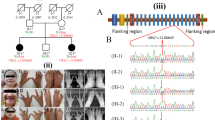Abstract
A South African family with autosomal dominant split hand, split foot (SHSF) malformation has been studied. The pedigree was unusual in that three unaffected siblings with normal parents had each produced affected offspring. New mutation, germinal mosaicism and autosomal recessive inheritance are unlikely. Possible explanations of this contentious situation may be an unstable premutation or non-penetrance due to an inhibiting factor associated with the gene responsible for SHSF. Pregnancy monitoring by ultrasound of unaffected close relatives of a person with SHSF is recommended.
Similar content being viewed by others
Abbreviations
- SHSF:
-
split hand, split foot
References
Barsky AJ (1964) Cleft hand: classification, incidence and treatment. J Bone Joint Surg 46:1707–1720
Birch-Jensen A (1949) Congenital deformities of upper extremitics. Ejnar Munksgaard, Copenhagen
Bonafede RP, Beighton P (1979) Autosomal dominant inheritance of scalp defects with ectrodactyly. Am J Med Genet 3:35–41
Burton BK, Hauser L, Nadler HL (1976) Congenital scalp defects with distal limb anomalies. J Med Genet 13:466–468
David TJ (1972) Dominant ectrodactyly and possible germinal mosaicism. J Med Genet 9:316–320
Freie-Maia A (1971) A recessive form of ectrodactyly and its implication in genetic councelling. J Hered 62–53
Graham JB, Badgley EC (1950) Split hand with unusual complications. Am J Hum Genet 7:44–55
Grubb R (1951) Observation on the human group system Lewis. Acta Pathol Microbiol Scand 28:61–81
Hanhart E (1945) Starke unregelmäßige Dominanz einer Anlage zur Spalthand. Arch Klaus-Stift, Vererb-Forsch 20:96
Johnston O, Davis RW (1953) On inheritance of hand and foot anomalies in six families. Am J Genet 5:356–372
Lange M (1936) Grundsätzliches über die Beurteilung der Entstehung und Bewertung atypischer Hand- und Fußmißbildungen. Verh Dtsch Orthop Ges 31:80–87
Lewis T, Embleton D (1908) Split-hand and split-foot deformities. Their types, origin and transmission. Biometrics 6:26–58
Mackenzie HJ, Penrose LJ (1951) Two pedigrees of ectrodactyly. Ann Eugenics 16:88–96
Majewski F, Küster W, Haar B, Goecke T (1985) Aplasia of tibia with split hand split foot deformity. Report of 6 families with 35 cases and considerations about variability and penetrance. Hum Genet 70:136–147
Neugebauer H (1962) Spalthand und-fuss mit familiärer Besonderheit. Z Orthop 95:500–506
Opitz JM (1985) Editorial comment: the developmental field concept. Am J Med Genet 21:1–11
Ray AK (1960) Another case of split foot mutation in two sibs. J Hered 61:169–170
Temtamy S, McKusick VA (1978) The genetics of hand malformations. Birth Defects 14:36–71
Verma IC, Josph R, Bhargava S, Metha S (1976) Split-hand and split-foot deformity inherited as an autosomal recessive trait. Clin Genet 9:8–14
Author information
Authors and Affiliations
Rights and permissions
About this article
Cite this article
Spranger, M., Schapera, J. Anomalous inheritance in a kindred with split hand, split foot malformation. Eur J Pediatr 147, 202–205 (1988). https://doi.org/10.1007/BF00442225
Received:
Accepted:
Issue Date:
DOI: https://doi.org/10.1007/BF00442225




